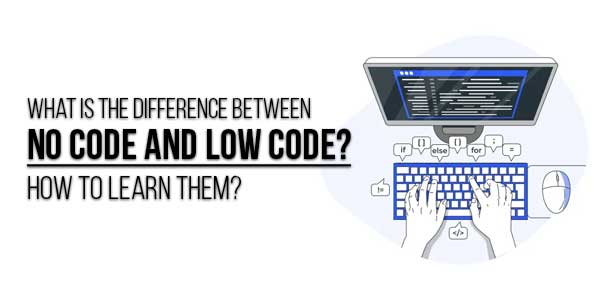
Table of Contents
NoCode Vs LowCode: Understanding The Key Differences And Learning Paths
In today’s fast-paced digital landscape, the demand for rapid application development has never been higher. Traditional coding methods are being challenged by two revolutionary approaches: NoCode and LowCode platforms. But what exactly sets them apart, and how can you leverage these powerful tools to bring your ideas to life without deep programming knowledge?
The Fundamental Distinction: NoCode Vs LowCode
At first glance, NoCode and LowCode might appear similar – both aim to simplify software development. However, their core philosophies and use cases differ significantly.
What Is NoCode Development?
NoCode platforms represent the ultimate democratization of software creation. These visual development environments allow complete beginners to build functional applications through:
- Drag-and-drop interfaces
- Pre-built templates and components
- Visual workflow designers
- Configuration-based logic
“NoCode isn’t about the absence of code – it’s about abstracting the complexity so anyone can create digital solutions regardless of technical background.”
What Is LowCode Development?
LowCode platforms sit between traditional coding and NoCode solutions. They provide visual development tools while still allowing for custom code when needed. Key characteristics include:
- Visual modeling combined with code extensibility
- Faster development than traditional methods
- Requires some technical understanding
- Better suited for complex applications
Comparing Core Features Side By Side
User Skill Requirements
NoCode platforms are designed for complete beginners – marketers, business analysts, and entrepreneurs can start building immediately. LowCode typically requires some programming fundamentals, making it better suited for professional developers looking to accelerate their workflow.
Customization Capabilities
While NoCode solutions offer impressive flexibility within their constraints, LowCode platforms shine when unique functionality is needed. The ability to drop into custom code gives LowCode an edge for specialized requirements.
Scalability Considerations
Enterprise-grade applications often favor LowCode due to better performance optimization and integration capabilities. NoCode solutions work wonderfully for prototypes, MVPs, and simple applications but may hit limits with complex scaling needs.
When To Choose NoCode Over LowCode
NoCode platforms excel in specific scenarios where speed and simplicity are paramount:
- Building quick prototypes to validate ideas
- Creating internal tools without IT dependency
- Developing simple customer-facing applications
- Automating business processes without coding
When LowCode Makes More Sense
Consider LowCode when your project requires:
- Custom functionality beyond standard components
- Integration with legacy systems
- Higher performance demands
- More control over the application architecture
Top Platforms In Each Category
Popular NoCode Platforms
The NoCode landscape has exploded with innovative tools:
- Webflow – For beautiful, responsive websites
- Bubble – Full web application development
- Adalo – Mobile app creation simplified
- Airtable – Database-powered applications
Leading LowCode Platforms
Enterprise-grade LowCode solutions include:
- Mendix – Comprehensive application development
- OutSystems – High-performance app creation
- Microsoft Power Apps – Deep Office 365 integration
- Appian – Business process automation

How To Learn NoCode Development
Mastering NoCode tools follows a different path than traditional programming education. Here’s an effective approach:
Start With The Fundamentals
Begin by understanding basic application architecture concepts. Learn about:
- User interface design principles
- Database structures and relationships
- Workflow automation basics
Choose Your First Platform Wisely
Select a beginner-friendly NoCode tool that aligns with your goals. For web apps, Bubble offers excellent learning resources. For websites, Webflow’s university provides superb tutorials.
Build Real Projects Immediately
The best way to learn NoCode is by doing. Start with simple projects like:
- A personal portfolio website
- A small business landing page
- A basic task management app
Mastering LowCode Development
LowCode learning requires blending visual development with programming concepts. Follow this progression:
Strengthen Your Technical Foundation
Before diving into specific platforms, ensure you understand:
- Basic programming logic (variables, loops, conditionals)
- Common data structures
- API fundamentals
Select An Industry-Standard Platform
Choose a widely adopted LowCode solution like OutSystems or Mendix that offers:
- Comprehensive documentation
- Active community support
- Certification programs
Progress From Visual To Hybrid Development
Start with visual modeling, then gradually incorporate:
- Custom JavaScript extensions
- API integrations
- Database optimizations
Career Opportunities In NoCode And LowCode
The demand for both skill sets is growing exponentially across industries.
NoCode Career Paths
Professionals can specialize as:
- NoCode developers
- Digital product designers
- Business automation specialists
LowCode Career Advancement
Experienced developers can transition into:
- LowCode architects
- Enterprise application developers
- Solutions consultants
Future Trends In Visual Development
The NoCode/LowCode landscape continues evolving with exciting developments:
AI-Assisted Development
Platforms are increasingly incorporating AI to:
- Generate components from natural language
- Suggest workflow optimizations
- Automate testing processes
Vertical-Specific Solutions
More specialized tools are emerging for industries like:
- Healthcare
- Financial services
- Education technology
Getting Started: Your Action Plan
Ready to dive into visual development? Follow these steps:
For NoCode Beginners
- Identify a simple project idea
- Select an appropriate NoCode platform
- Complete the platform’s official tutorials
- Join relevant online communities
- Build and iterate on your first project
For Developers Exploring LowCode
- Assess your current programming skills
- Choose an enterprise-relevant LowCode tool
- Complete certification training
- Experiment with extending visual components
- Contribute to open-source LowCode projects
Whether you choose NoCode or LowCode, you’re embracing the future of software development. These approaches aren’t replacing traditional coding – they’re expanding who can participate in creating digital solutions. The best approach depends on your goals, technical comfort level, and the complexity of projects you want to tackle.


















Be the first to write a comment.